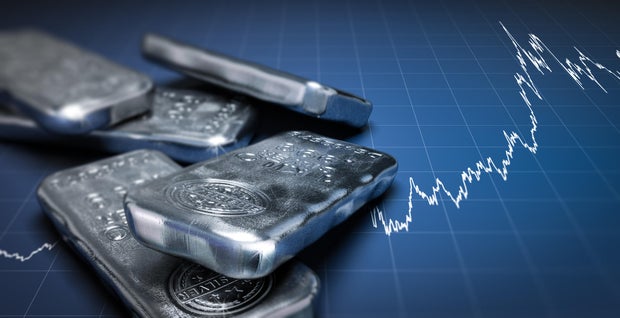Getty Images/iStockphoto
Gold prices have had a serious run-up over the last few years. With stubbornly high (but now cooling) inflation, geopolitical turmoil, stock market volatility and economic uncertainty, many consumers have flocked to the precious metal, both for a safe-haven investment and a smart way to diversify their portfolios.
But what about gold’s lighter-hued counterpart? Is silver experiencing the same type of gains? Here’s what experts say you should know about silver pricing — and what investing in the precious metal could mean for your portfolio today.
Find out more about adding precious metals to your portfolio now.
Has silver’s price also been rising? What experts say to know now
Silver prices are certainly up over the last year. The current price sits at about $33 per ounce, up from just under $27 per ounce a year ago.
“Silver is up 25% from a year ago and has room to run higher, with many analysts predicting $40 per ounce by end of year,” says Brett Elliott, director of content at precious metals marketplace APMEX. “This is roughly a 20% gain from current levels, which would be an excellent return if price action follows the expected path.”
Historically, though, the $35 mark has been “a key resistance level” for silver, and it could be challenging to see prices get over that initial hump, Elliott says.
“The wildcard is going to be the economy,” Elliott says. “Silver does not perform well when the economy is not performing well. If tariffs have a dramatic impact on GDP or global trade, it’s possible that silver reacts adversely and that could show up as price weakness in the second half.”
How the Federal Reserve proceeds at its June and July meetings will play a big role, too, says Steven Conners, founder and president of Conners Wealth Management.
“If the Federal Reserve bank cuts the federal funds rate — the overnight lending rate in the U.S. — then silver may have some good appreciation,” Conners says. “The main reason is that interest rate investments will pay less, and since silver doesn’t pay interest, it could make it more appealing for other investors.”
Learn more about the benefits of gold and silver investing today.
Is silver a good investment alternative right now?
Whether silver is a good investment depends right now on your goals. If you’re hoping for big returns, for example, it’s likely not your answer.
“Depending on the dates chosen within the last 40 to 50 years, the compound annual growth rate of silver ranges from 3% to 4.12%,” says Ronnie Gillikin, president and CEO of Capital Choice of the Carolinas. “Silver prices have historically been very volatile. The risk of volatility is too high for the assumed rate of return.”
If you’re looking for a hedge against market volatility, though, silver can be smart, but it wouldn’t do much good at this very moment, Conners says.
“Silver is not a good investment right now, primarily because the stock market is rising,” Conners says. “However, as we have seen this year in particular, stock prices have been very inconsistent. When stock prices decline, silver rises.”
Gold can serve a similar purpose, offering your protection against fluctuations in other asset classes. And while you can technically buy both as a safeguard, keep in mind that “silver and gold tend to correlate,” so doing so may be unnecessary.
The two major reasons you might want both? First, silver is more affordable. You can buy into silver on a smaller budget and get protection without giving up a lot of capital. On top of this, the two metals have different uses, which could impact supply and pricing depending on where the economy goes.
“Gold is the best hedge against inflation; however, silver has industrial properties,” Conners says. “Should the economy accelerate from current levels, silver may outperform. Industrial uses include photovoltaic solar panels, mirrors, circuit boards, and batteries to name some major uses.”
The bottom line
At the end of the day, silver prices are volatile and hard to predict, and that could put you at risk if you invest too much into the metal.
“Precious metals should comprise between 5 and 10% of a portfolio,” Conners says. “There should also be major inflationary trends in place before increasing lower percentages of a particular portfolio.”
If you’re not sure if silver — or how much of it — is right for your portfolio, talk to an investment professional. And, if you opt for physical silver or gold, go in with a plan for storing and insuring it. This will help protect your investment in the long haul.




